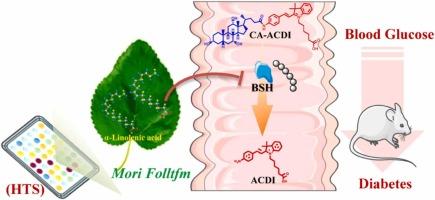利用开发的荧光探针发现森福芬的α-亚麻酸是胆酰甘氨酸水解酶抑制剂,可缓解 2 型糖尿病
IF 8
1区 化学
Q1 CHEMISTRY, ANALYTICAL
引用次数: 0
摘要
胆酰甘氨酸水解酶(CH)又称胆盐水解酶,由肠道微生物群表达,在水解共轭胆汁酸的过程中发挥着关键作用,影响着各种胆汁酸的组成和含量。本研究开发了一种胆酸与半胱氨酸衍生物的共轭物(CA-ACDI),作为检测 CH 活性的酶促荧光探针,显示了在该领域的潜在应用。通过使用 CA-ACDI 对 CH 活性进行高通量筛选,从 95 种传统草药中发现了森福罗是一种重要的 CH 抑制剂。利用各种色谱技术和光谱数据进行的进一步分析表明,α-亚麻酸是森叶中负责抑制 CH 活性的关键生物活性成分。重要的是,α-亚麻酸作为一种天然 CH 抑制剂,已被证明能通过 FXR 信号通路显著调节 2 型糖尿病(T2DM)小鼠模型的葡萄糖代谢。这项研究不仅开发了一种新型荧光探针,用于检测CH,还发现了可能有助于缓解2型糖尿病的潜在CH抑制剂。本文章由计算机程序翻译,如有差异,请以英文原文为准。

α-Linolenic acid from Mori Folltfm found as Choloylglycine hydrolase inhibitor by the developed fluorescent probe to alleviate type 2 diabetes
Choloylglycine hydrolase (CH), also known as bile salt hydrolase, is expressed by intestinal microbiota and plays a key role in the hydrolysis of conjugated bile acids, influencing the composition and levels of various bile acids. In this study, a conjugate (CA-ACDI) of cholic acid and a semi-cyanine derivative was developed as an enzyme-activated fluorescent probe for detecting CH activity, showing potential applications in this area. By the high-throughput screening of CH activity using CA-ACDI, Mori Folium was identified as a significant CH inhibitor from a collection of 95 traditional herbal medicines. Further analysis using various chromatographic techniques and spectroscopic data identified α-linolenic acid as the key bioactive component in Mori Folium responsible for inhibiting CH activity. Importantly, α-Linolenic acid, as a natural CH inhibitor, was shown to significantly regulate glucose metabolism in a type 2 diabetes mellitus (T2DM) mouse model via the FXR signaling pathway. This work not only developed a novel fluorescent probe for CH detection but also discovered potential CH inhibitors that may help alleviate type 2 diabetes.
求助全文
通过发布文献求助,成功后即可免费获取论文全文。
去求助
来源期刊

Sensors and Actuators B: Chemical
工程技术-电化学
CiteScore
14.60
自引率
11.90%
发文量
1776
审稿时长
3.2 months
期刊介绍:
Sensors & Actuators, B: Chemical is an international journal focused on the research and development of chemical transducers. It covers chemical sensors and biosensors, chemical actuators, and analytical microsystems. The journal is interdisciplinary, aiming to publish original works showcasing substantial advancements beyond the current state of the art in these fields, with practical applicability to solving meaningful analytical problems. Review articles are accepted by invitation from an Editor of the journal.
 求助内容:
求助内容: 应助结果提醒方式:
应助结果提醒方式:


